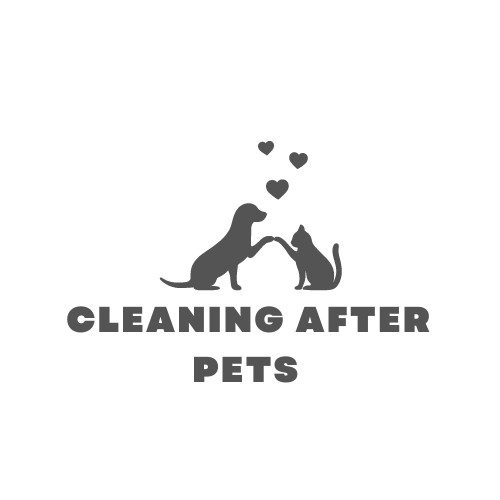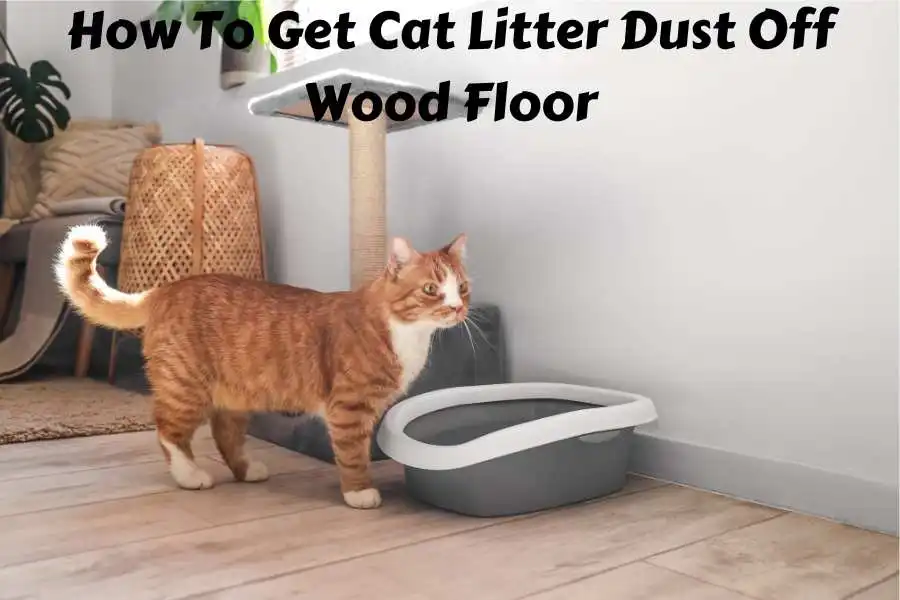Dealing with cat litter can be challenging for a cat owner with hardwood floors. Not only does the litter box need to be cleaned regularly, but you must also take steps to prevent the litter from getting all over your floors. With this in mind, you ought to learn how to get cat litter dust off wood floors.
This guide will provide tips and tricks for keeping your hardwood floors clean in the face of cat litter.
Can Kitty Litter Stain A Wood Floor?
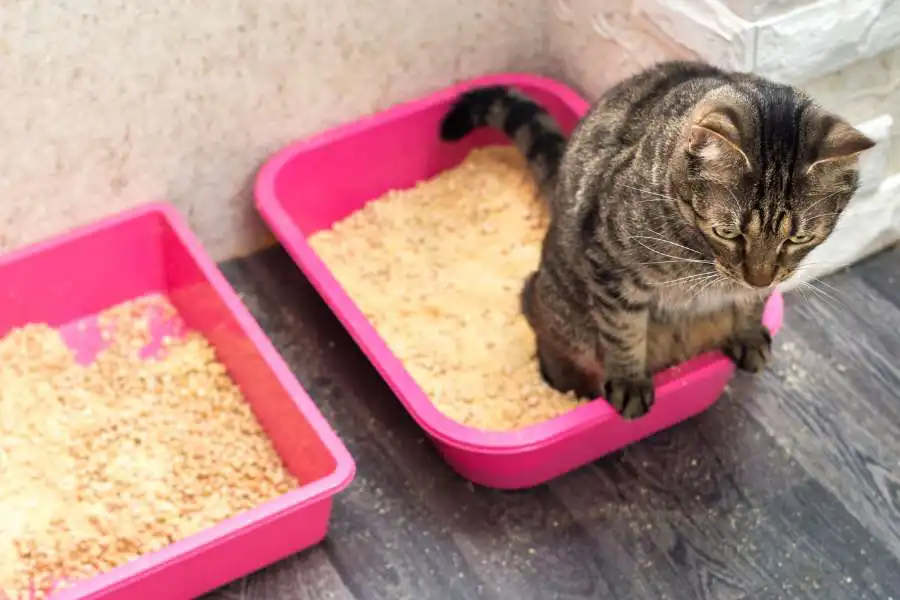
The simple answer is yes, mainly when the wood floor is not cleaned faster and well enough after the stain has occurred. You also must remember that some types of cat litter have chemicals and dying compounds that are likely to discolor your wood floor when allowed to stay in place for a long duration.
Cleaning the spills as soon as possible is one of the best ways to prevent cat litter from staining the wood floor in your home. And it does not have to be an elaborate cleaning affair.
Spot cleaning the mess will prevent hardwood floor staining or other forms of damage.
To spot-clean a cat litter mess, begin by vacuuming up the litter. Ensure you eliminate all of the stray litter that could have been accidentally knocked out of the litter box or scattered around the floor.
Alternatively, you can sweep the litter with a broom.
To make your life easier, consider investing in a robot vacuum cleaner that works in the background to keep your hardwood floor cat litter- and dust-free. It is especially effective if you have multiple cats.
If you’re dealing with wet cat litter, you can spot-clean the mess with a damp cloth or paper towel and blot out any remaining wetness using a clean and dry towel. Avoid using abrasive brushes or tough cleaning products that may ruin or discolor your hardwood floor.
Learn How to Get Rid of Cat Litter on Your Carpet
Cleaning With Water And Vinegar
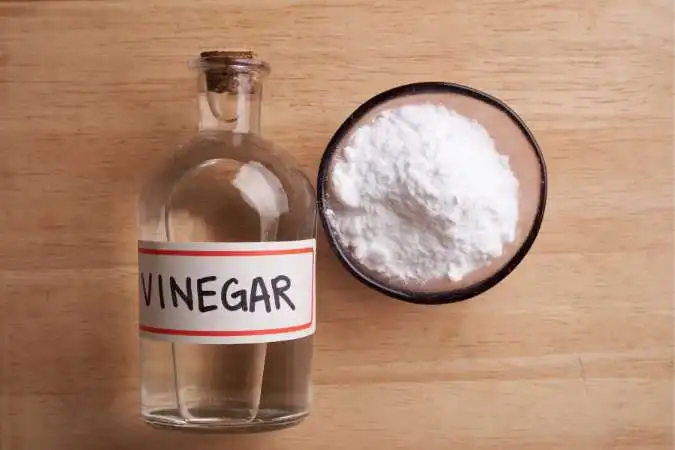
While not requisite for cat ownership, learning how to get cat litter residue off hardwood floors is important for a stress-free experience while living with your furry friend.
You do not want to panic-clean your hardwood floor when you find clumped litter on the floor, inadvertently scratching up your floor.
Ideally, your cleaning method should be tough on the stain while being gentle on the wood.
Cleaning the affected area with water and vinegar is safe and effective. Here are some tips for using this method:
- Mix equal parts water and white vinegar in a spray bottle.
- Spray the solution onto the affected area and let it sit for a few minutes.
- Wipe the area clean with a microfiber cloth or mop. If the litter has dried on the color, consider using a soft-bristled brush to loosen the litter.
Vinegar is an eco-friendly disinfectant that effectively cleans cat litter and pet stains from your wood floor. It will help eradicate bacteria lurking around the urine and/or poo-infested cat litter.
Unlike most commercial cleaning products with harsh chemicals, vinegar is a mild abrasive cleaner and less likely to damage or discolor your wood floor.
Using Commercial Hardwood Cleaner
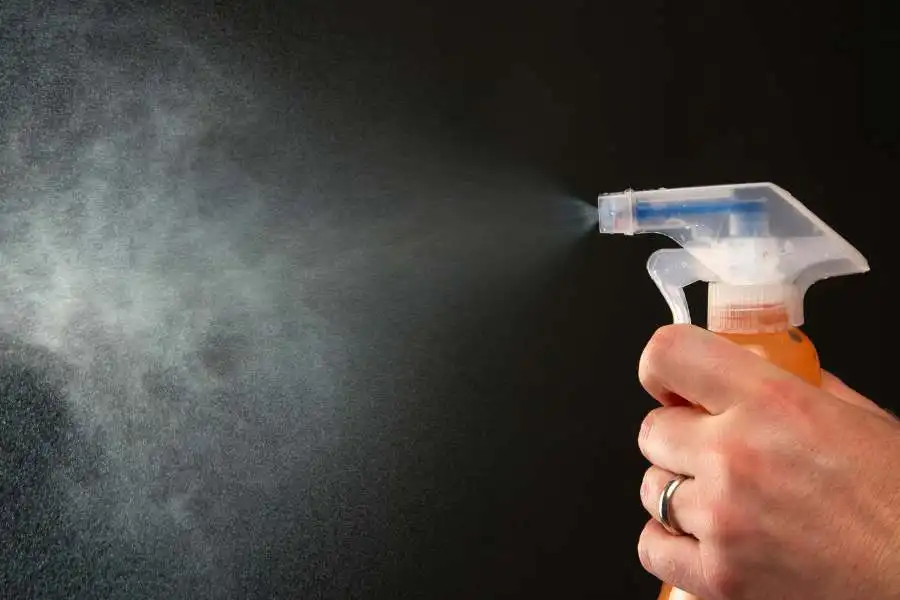
Try a commercial hardwood floor cleaner if the vinegar solution doesn’t work. Look for a product specifically designed for hardwood floors, such as Murphy Oil Soap which is a natural and effective solution for getting rid of grease, grime, dirt, and food stains on wood floors.
Generally, applying a store-bought hardwood cleaner is an effective way to eliminate cat litter stain on wood floors. However, when buying a hardwood cleaner, ensure that you choose a safe product for your type of hardwood floor.
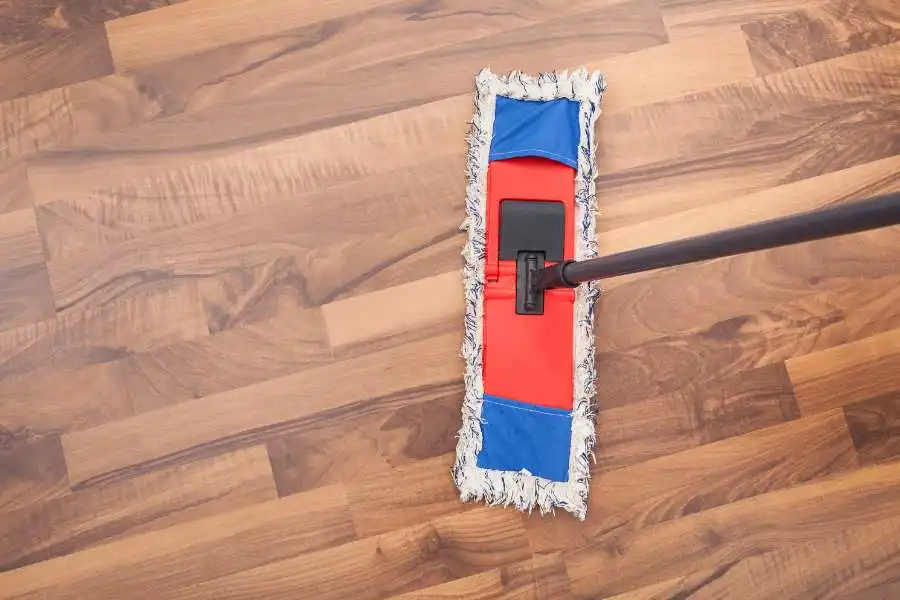
- Begin by eliminating all litter particles around the affected floor area.
- Use a mop or a clean cloth to apply the hardwood cleaner to the affected area.
- Let the hardwood cleaner sit for some time. The exact period depends on your hardwood cleaner, so ensure you read and follow the manufacturer’s instructions. In addition, consider testing the cleaner on a hidden area of the floor to protect it from discoloration.
- If the stain proves more stubborn than you anticipated, you can use a soft-bristled brush to gently scrub the stain out, taking care not to scratch or damage the floor.
- Finish by wiping the spot with a clean and slightly damp cloth, and use a dry, and clean cloth to dry your floor.
Deodorizing Hardwood Floors
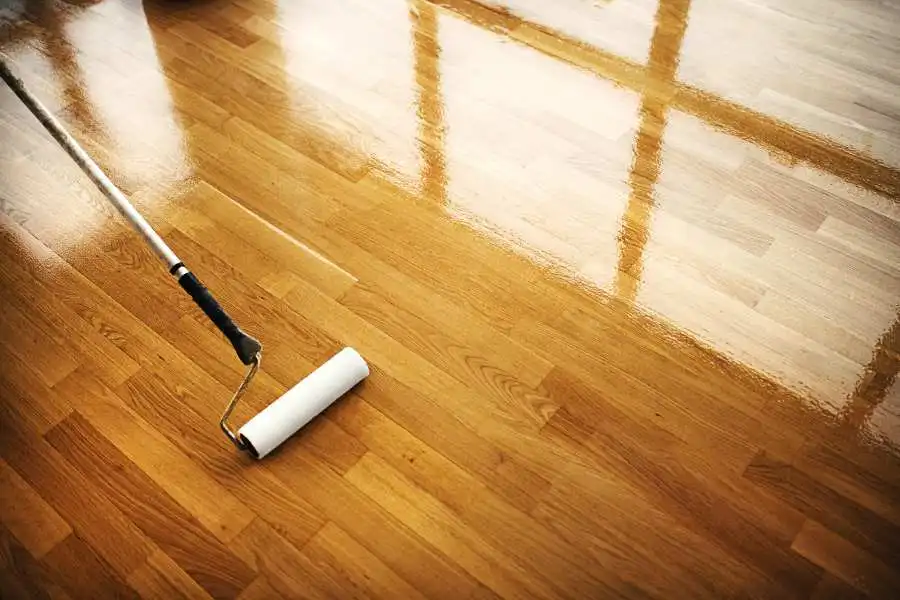
Deodorizing the affected spot after removing the cat litter stain is necessary to freshen the smell from the recently-cleaned area. Cat urine sticks around and reeks of a pungent ammonia odor long after you clean the stain.
Fortunately, deodorizing your floor is easy and straightforward. If you cleaned the soiled spot with vinegar, you could repeat the process until all of the odor dissipated completely. Apply one part water and one part vinegar to the floor area using a clean cloth.
Allow a few minutes before wiping off the vinegar solution with a clean, dry towel.
Alternatively, you can use baking soda. Sprinkle some baking soda on the stained spot and allow it to sit for at least 30 minutes before wiping and vacuuming it.
Also, you can use a wood primer to seal the wood, blocking the urine odor within the wood. Ensure you use an effective wood primer like the ZINSSER shellac-based wood primer.
Preventing Future Messes
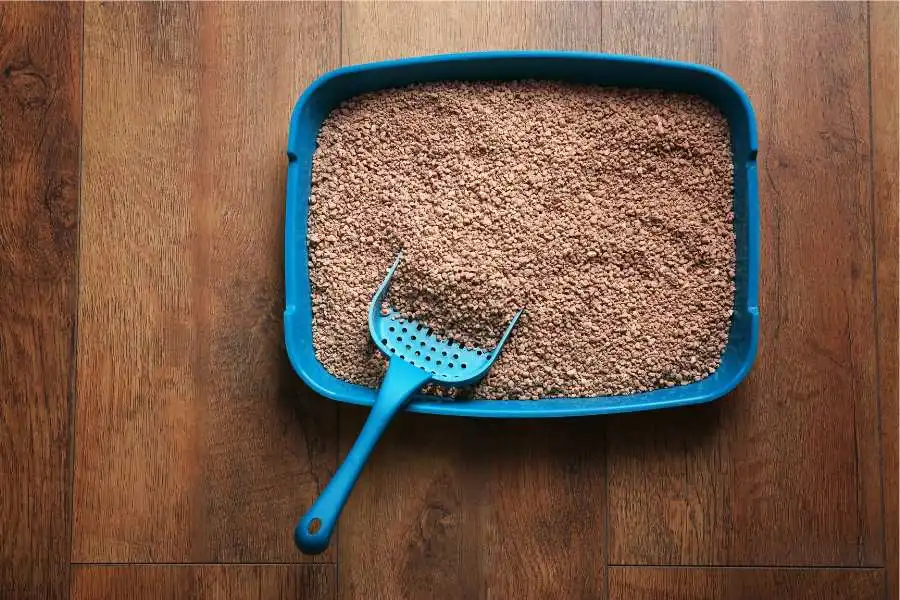
#1. Choosing The Right Litter (Actually Dust-Free Cat Litter)
The type of litter you use will influence how much dust and residue that emanates from the box. It can also determine how well you safeguard your cat’s respiratory health as it uses the litter box.
Additionally, you should consider buying cat litter that does not track; ordinarily, it should have large, light pellets that do not stick in your cat’s paws.
The choices for cat litter are numerous. Importantly, each type of cat litter, whether cheap or expensive, has unique implications for your cat’s behavior, health, and home environment, including your wood floor. Some types of litter are more prone to leaving a mess than others.
As such, when selecting litter, look for these characteristics:
- Low-dust: This type of litter produces less dust when your cat digs, reducing cat litter dust falling on your floors. Clay and crystal litters are usually the worst offenders when it comes to dust. Read the label on the cat litter you are about to buy: Look for cat litter labeled “low-dust” or “dust-free.”
- Large granules: Litters with larger granules are less likely to stick to your cat’s paws, reducing the risk of your cat tracking the litter onto your hardwood floor. Also, larger litter pellets are less likely to scatter over your wooden floor.
- Unscented: Scented litters often contain chemicals that can harm cats and irritate their respiratory systems. Also, self-clumping litter is less likely to scatter and may be favorable for your cat, so keep that in mind as you choose the ideal cat litter for your pet.
- Prioritize using cat litter made from natural materials: Usually, cat litter that contains natural materials like paper, activated charcoal, corn, pine shavings, or wheat generates less dust compared to traditional clay litter. In addition, cat litter made from natural materials is eco-friendly and less likely to stain your wood floor.
- Buy the litter your cat prefers: You may need to experiment with various types of cat litter to determine your cat’s favorite option based on scent and texture.
- Consider consulting a qualified vet to help you select the most suitable litter for your cat.
#2. Placing The Litter Box Strategically

Where you place the litter box can also affect how much litter ends up on your floors. It can also encourage your cat to use the litter box more consistently. Here are some tips for finding the best location for your litter box to minimize messes:
- Choose a low-traffic area: The more people and pets walk past the litter box, the more likely it will be kicked. Also, look for a quiet location to place the litter box to encourage your cat to use it rather than relieve itself on your clothes, your beautiful carpet, or the shoes you’ve placed in the closet.
- Avoid placing the litter box near your cat’s food or water bowl: Most cats do not like going to the bathroom close to where you serve them food and water.
- Place the litter box in an easy-accessible location: You do not want to subject your cat to unnecessary struggle when it has to go to the litter box. Consequently, keep the litter box in an easily accessible place, particularly if the cat is old or sickly.
- Use more than one litter box: Consider buying multiple litter boxes, especially if you have more than one cat. Cats can be quite territorial, and it is best for everyone when every cat has its litter box. In other circumstances, you will need to follow the “one plus one” rule of thumb for cat litter, where you provide an extra litter box for each one of your cats.
- Ensure the litter boxes are clean: You must scoop out your cat’s waste at least once a day. Cats hate using dirty litter boxes, and you can prevent the spread of cat poop odor in your home.
#3. Using A Mat Under The Litter Box

One of the simplest ways to keep litter from getting all over your floors is to use a mat under the litter box. Here are some tips for using a mat to keep your floors clean:
- Choose the right type of mat: Look for a mat with a textured surface that will trap litter and prevent it from being tracked around the house.
- Clean the mat regularly: Shake it out or vacuum it to remove any trapped litter, and wash it with soap and water as needed.
- Consider using multiple mats: Place one mat under the litter box and another in front and beside the box to catch any tracked litter.
The main purpose of laying a mat beneath the litter box is to trap any litter accidentally thrown or tracked out of the box by your cat.
The mat helps stop the litter from spreading and scattering to other parts of your wood floor and helps you clean properly after your cat.
When considering the type of mat to buy, look for one sufficiently big to accommodate the litter box. A textured mat has stronger non-slip properties and can help trap litter better.
For your benefit as a cat owner, look for a mat that is easy to clean and maintain.
#4. Sweeping And Vacuuming Regularly
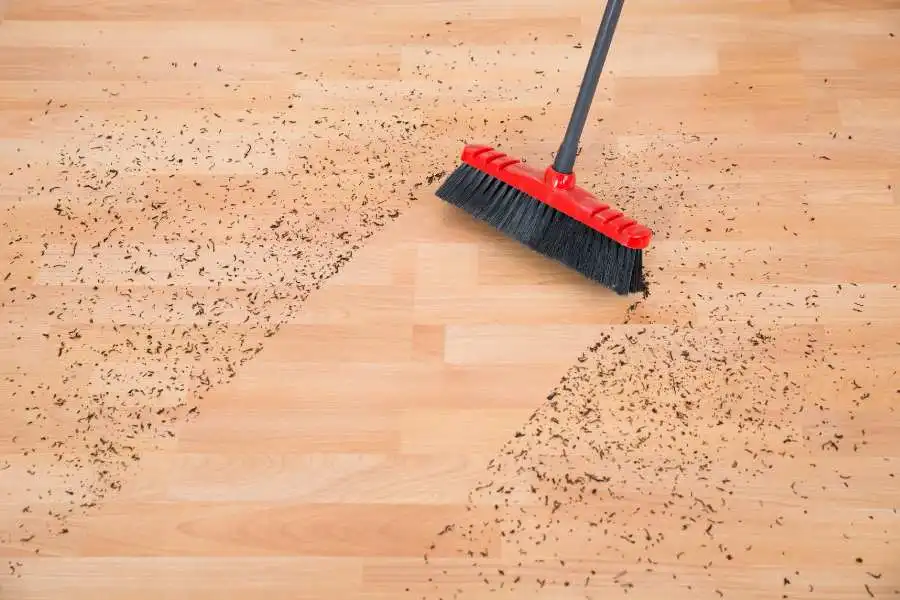
Even with the best litter and litter box placement, you will still need to do some cleaning to keep your floors looking their best. Sweeping and vacuuming help to eliminate displaced litter or debris from your wood floor. It also stops or reduces litter tracking throughout your wood floor.
Here are some tips for sweeping and vacuuming your floors to remove cat litter dust and residue:
- Use a broom or vacuum with a hard floor setting: This will help prevent scratches on your hardwood floors.
- Sweep or vacuum daily: The more frequently you clean, the less litter and litter dust will accumulate on your floors.
- Use a dust mop or microfiber mop: These tools are great for picking up fine dust and residue that a broom or vacuum may miss.
- You may need a soft-bristled brush attachment to avoid damaging or scratching the wood floor.
Quick Pointers On How To Keep Litter from Getting Everywhere
In addition to regular cleaning, selecting the right type of litter, and placing a mat below the litter box, there are some steps you can take to prevent future cat litter messes on your hardwood floors. Here are some tips:
- Trim your cat’s nails regularly: This will reduce the amount of litter kicked up and scattered around the litter box.
- Use a litter box with a hood: This will help contain litter and prevent it from being kicked or scattered outside the box.
- Consider a self-cleaning litter box: These litter boxes automatically scoop and deposit waste into a container, minimizing the amount of scattered litter.
Following these tips and tricks, you can keep your hardwood floors looking their best in the face of cat litter. Remember to choose the right litter, place the litter box strategically, use a mat under the litter box, sweep and vacuum regularly, spot clean with water and vinegar, and take steps to prevent future messes.
Learn How To Clean Cat Litter On Concrete Floors
Conclusion: How To Get Cat Litter Dust Off Wood Floor
Hardwood floors can be a beautiful addition to any home, but they require extra care and maintenance when you have cats. Following the tips and tricks outlined in this guide, you can keep your floors looking clean and pristine, even in the face of cat litter. You can create a happy and healthy home for you and your feline friends with a little effort.
FAQs
Q. Can cat litter damage hardwood floors?
A. Yes, cat litter can damage hardwood floors if left on the floor for an extended period of time. The abrasive nature of the litter can scratch the surface of the hardwood, causing it to become dull and damaged.
Q. Can I use a steam mop on my hardwood floors to clean up cat litter?
A. No, using a steam mop on hardwood floors is not recommended. The high temperature and moisture can cause the wood to warp and become damaged. Stick to using a dry mop, broom, or vacuum to clean up cat litter.
Q. How often should I clean my cat’s litter box to prevent messes on my hardwood floors?
A. It is recommended to clean your cat’s litter box and the surrounding floor at least once a day to prevent messes on your hardwood floors. A clean litter box will encourage your cat to use it and reduce the amount of litter kicked or scattered around it.
Q. Can I use bleach to clean up cat litter messes on my hardwood floors?
A. No, it is not recommended to use bleach on hardwood floors. Bleach can discolor and damage the wood. Stick to using water, vinegar, or a commercial hardwood floor cleaner to clean up cat litter messes.
Q. How can I train my cat not to kick litter out of the litter box?
A. You can try a few things to train your cat not to kick litter out of the box. First, ensure the litter box is big enough for your cat to move around comfortably. Second, use a litter mat to catch the stray litter under the box. Third, consider switching to a litter box with a hood or a self-cleaning litter box to contain litter and prevent it from being kicked or scattered outside of the box.
